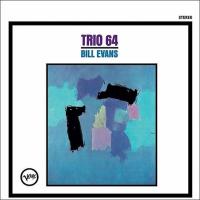Bill Evans Trio '64 Brought A Light Touch to a Dark Time
The late bassist Scott LaFaro’s friend Gary Peacock replaced him in the trio with Paul Motian continuing on drums. Though no less cerebral and harmonically tuned in than was LaFaro, Peacock brought to the group a faster, more aggressive rhythmic style punctuated with nimble staccato runs. More tapping of the toes and less tugging at the heart.
The set of tuneful standards includes some well-known material including “Dancing in the Dark” and “A Sleeping Bee” (which became part of Evans’ repertoire), the oft covered “Everything Happens To Me”, as well as two unusual choices “Santa Claus is Coming To Town” and “Little Lulu”—a tune created for the comic book character’s 1940’s era theatrical short films. The group extracts from these novelty songs depth and character, discarding the simple surface sentiments.
Recorded by Bob Simpson in New York’s Webster Hall, it would be fair to think of this as an RCA “Living Stereo” production released on Verve (Simpson also recorded Belafonte at Carnegie Hall among many other classic RCAs). The relatively closely-miked sound is delicate throughout. Simpson was a recording master who knew how to capture a piano, which here floats effortlessly and three-dimensionally slightly right of center stage with Peacock in the left channel and Motion in the right, neither sounding isolated but rather as part of an organic whole.
The relatively short program approximately 15 minutes to a side allowed mastering engineer Ryan K. Smith to put all of what’s on the tape into the grooves without going anywhere close to the label.
The QRP pressing was dead silent and the Stoughton laminated Tip-on jacket is as pleasing to look at as it is satisfying to the touch. This reissue wins compared to an oft-played, finely produced Japanese Polydor reissue (23MJ 3033), though that one is also very good.
This reissue is as good as any to explain in sound what AAA vinyl is all about, plus of course the performance will every play elevate your mood and get your toes tapping. How these guys brought that lighthearted a mood to a session recorded a month after the Kennedy assassination remains difficult to understand, but it was just what the jazz record buying public needed.



